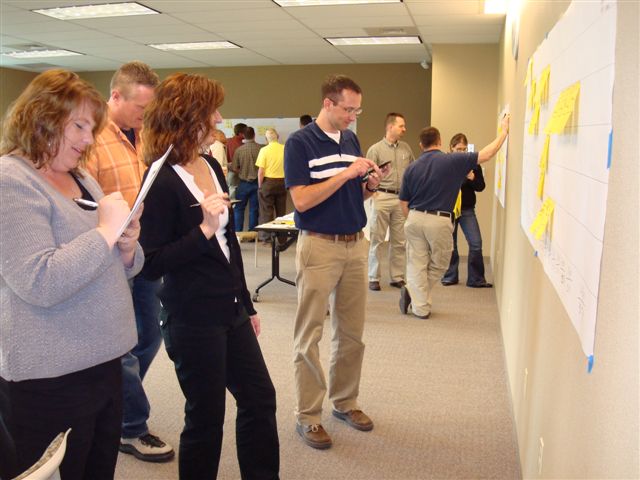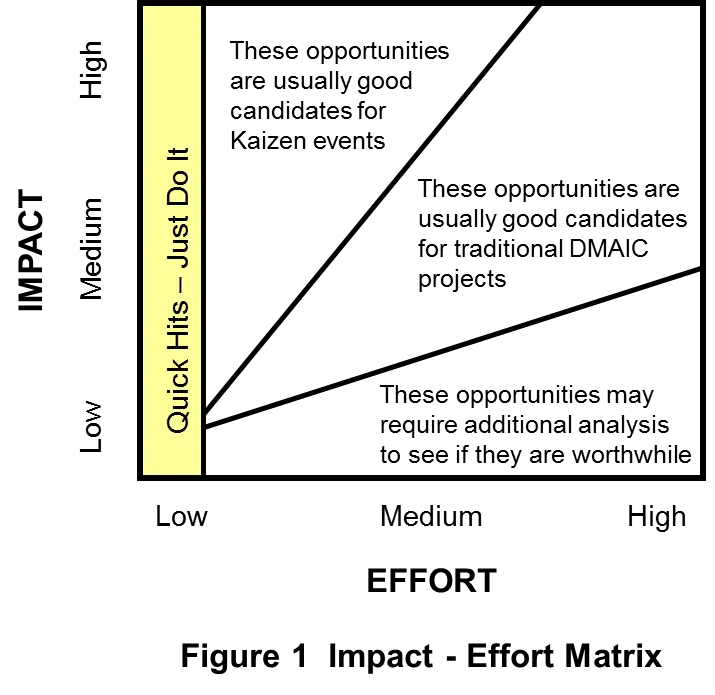Kaizen is commonly known to mean "continuous improvement". The goal of a Kaizen event is process improvement through the elimination of waste and/or reduction of variability.
Kaizen events differ from traditional Lean Six Sigma projects in that the team comes together for intensive project work over a short period of time, usually lasting three to five days. The overall duration of a Kaizen event, including preparation (1-2 weeks) and follow-up (2-3 weeks), is about four to six weeks, compared to the eight to twelve weeks normally allocated for a traditional Lean Six Sigma project.
To ensure that Kaizen events are aligned with an organization's strategic objectives and are based on real business needs, organizations may want to apply the following approach. After selecting the process to be improved, an initial one- or two-day workshop with the leadership team responsible for that process focuses on mapping the entire value stream and identifies a set of key metrics. This workshop is then followed by a period where a team of Lean Six Sigma trained employees validates the value stream map, collects data around the identified key metrics, and establishes an initial process dashboard. In a second management team workshop, this initial dashboard is reviewed, a future state map is been developed and a list of high-impact projects that would be necessary to accomplish the future state is identified. Finally, the leadership team reviews the list of projects and identifies which methodology and/or approach should be used to address each.

There are three key types of resources in a Kaizen event:
Project Sponsor: In most cases, the Project Sponsor is the manager that has authority over the process or work area where the event will take place. The Project Sponsor helps to write the project charter, interfaces with the management team, approves the budget, and helps to remove any obstacles or roadblocks that may arise during the implementation phase.
Kaizen Facilitator: The Kaizen Facilitator is responsible for the preparation and final results of the event, and manages the agenda during the event.
Team Members: Team Members typically include people who work with the process to be improved on a daily basis or experts from other functions, e.g. IT or Human Resources.
To determine if an improvement opportunity should be tackled through a Kaizen event or a traditional Lean Six Sigma project, an Impact - Effort Matrix has been proven to be a very helpful tool. After brainstorming potential opportunities and completing some initial scoping work on the most promising candidates, these candidates are then placed in the Impact - Effort Matrix as shown in Figure 1.
 Impact - Effort Matrix:
Impact - Effort Matrix:
- Improvement opportunities falling into the medium- to low-effort & high-impact area are ideal Kaizen event projects.
- Candidates in the low-effort & low-impact area are often "Just Do It !" activities and may not require any formal project approach.
- Opportunities falling into the high-effort & low-impact area often require additional analysis to decide if the benefit really justifies the hard work required.
- Projects that fall into the middle ground or the medium- to high-effort & medium- to high-impact area are often more complex and require a longer time frame. These are in most cases ideal candidates for traditional Lean Six Sigma projects.
The Seven Key Factors for a successful Kaizen Event are described below.
Sponsor Involvement: Kaizen events are most effective when the sponsor is highly visible and involved in all aspects of the event. This is critical in most cultures, especially those where there is significant resistance to change; such organizations will require a high degree of barrier resolution throughout the project.
Kaizen Facilitator: Effective Kaizen events happen only when there is a good facilitator - someone who understands the possibilities and limitations of this approach, who can encourage good participation and brainstorming, and who will keep the team focused. The facilitator should be good at managing team members, able to assign roles and responsibilities and deal with the issues, and know the appropriate set of tools for the event.
Workplace Preparation: The sponsor and facilitator need to identify what needs to be done to prepare the team to be out in the workplace - especially if they do not normally work in the area. This includes, confirming any safety procedures; informing the production scheduler in advance about any machine downtime; coordinating with the maintenance team to ensure that required equipment will be available to the Kaizen team; connecting with the process owner, work area supervisor, or manager if that person is not the sponsor; and involving the union shop steward to discuss the event and any potential issues and barriers.
Kaizen Scoping & Objective Setting: Another critical consideration is how to properly define the project. Too broad a scope and the team will find it impossible to complete the work. Too narrow and the payback may not justify the effort and time invested. The project scope needs to be discussed with and approved by the project sponsor. For the facilitator, it is important to know what topics the team should work on and, equally important, should not work on. As part of scoping the project, one to three key metrics need to be defined and goals need to be agreed upon to measure the impact of the project.
Development of New Work Standards: The basis of change in most Kaizen projects is the development and deployment of a new standard work, defined and verified by the team through trials and experimentation. Once the new standard is defined, time should be given to training people on the use of the standard: the steps, the sequence of steps, the tools used to do the work, and the time to perform each step.
Visual Tools & Visual Management: Kaizen events have a very strong visual component, which is important to adopt as part of the organizational change management process. Visual Management tools include, prominently posting the value stream map the team creates in the meeting room; posting before-and-after photos of the workplace; using visual tools and controls embedded in methods like 5S Visual Workplace Organization; documenting new standards and control plans, and displaying results from the event on whiteboards. Often, follow-up meetings will take place around these whiteboards. These Kaizen boards are also a great tool to present and visualize the continuous improvement activities and culture to Customers during factory tours.
Celebrating & Publicizing Accomplishments: Successful Kaizen events play an important role in changing the culture of an organization towards Operational Excellence. Participants experience the power of Lean Six Sigma tools firsthand. Their success and confidence often spill over to coworkers. Celebrating the results of the event with the team and publicizing their achievements to the broader organization are actions that help drive this cultural change.
Change happens very slowly in most organizations, where people remember the last time that change was attempted, and either ignore the new solutions or simply watch and wait for the next priority to attract management's attention.
However, changes that have been demonstrated to improve performance during pilot runs should be non-negotiable - that is they are not optional and need to be embraced by all the people involved. The team needs to understand that changes are expected.
When people see how the changes benefit their work and how the results are measured and rewarded, the culture of change starts to take place.
To learn more about Lean Kaizen Events and other Lean Management tools, visit our OpEx Academy for Training Materials, eLearning Modules, Online Courses, and Public Workshops offering.
Benefit from our expertise and experience to help organizations drive profitability and create growth through Operational Excellence. Contact Us to discuss how Operational Excellence Consulting can support you and your organization in establishing or accelerating your own Operational Excellence initiative. Follow us on LinkedIn and Facebook.
Experience. Passion. Results.
